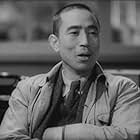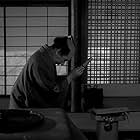- Director
- Writer
- All cast & crew
- Production, box office & more at IMDbPro
Featured reviews
"Nihon kengo den" (Duel at Yagyu Valley, 1945) is a Toho studios chanbara film with big stars and nice scenery. The film was penned by Mimura Shintaro and directed by Takizawa Eisuke, and was probably made with a considerably smaller budget than usual, money being tight because of the war situation in the spring of 1945. It manages to turn the financial short-comings into an advantage however, as the bulk of the film has been made outdoors in locations with refreshing scenery. It also has big jidai-geki stars, that many fans will recognize.
I would guess that the American censors later cut a bunch of the film, as it now is less than an hour in duration. This hour did not include propaganda though, and for genre fans, this is an easy film to digest. The plot-line is basic, and resembles a lot of the Zatoichi films of the 1960's. We have a wonderer from the house of Hosoin, who is an expert in martial arts, fencing included. He arrives to this region with forests and mountains and meets a bunch of bad guys, or at least opposing characters who are just hanging out in the forest, waiting for someone to come so that they could practice fencing, I guess. He doesn't want to oblige them, so they pick on the next guy who comes along, ending up killing the poor dude. The protagonist meets the brother and sister of the guy who died, and the killers are trying to frame our main guy for the murder. However, this story-line does not take too long to come to an end, and after he has settled things, the protagonist goes to a more official match with an opponent of note. I won't spoil the ending, but it was unusual: probably my favorite thing in the movie.
The film is nothing amazing, as a story, but because of the short length, it was pretty watchable. Fujita Susumu from Kurosawa's "Sugata Sanshiro" (1943) is also in the film. Last year, I watched director Takizawa's previous film "Ina no Kantaro" (1943), and "Nihon kengo den" is certainly the better film. However, it is considerably tame and light, compared to post-war chanbara films, and even in 1945, Mizoguchi's "Meito bijomaru" and Kurosawa's "Zoku Sugata Sanshiro" were somewhat better films.
I would guess that the American censors later cut a bunch of the film, as it now is less than an hour in duration. This hour did not include propaganda though, and for genre fans, this is an easy film to digest. The plot-line is basic, and resembles a lot of the Zatoichi films of the 1960's. We have a wonderer from the house of Hosoin, who is an expert in martial arts, fencing included. He arrives to this region with forests and mountains and meets a bunch of bad guys, or at least opposing characters who are just hanging out in the forest, waiting for someone to come so that they could practice fencing, I guess. He doesn't want to oblige them, so they pick on the next guy who comes along, ending up killing the poor dude. The protagonist meets the brother and sister of the guy who died, and the killers are trying to frame our main guy for the murder. However, this story-line does not take too long to come to an end, and after he has settled things, the protagonist goes to a more official match with an opponent of note. I won't spoil the ending, but it was unusual: probably my favorite thing in the movie.
The film is nothing amazing, as a story, but because of the short length, it was pretty watchable. Fujita Susumu from Kurosawa's "Sugata Sanshiro" (1943) is also in the film. Last year, I watched director Takizawa's previous film "Ina no Kantaro" (1943), and "Nihon kengo den" is certainly the better film. However, it is considerably tame and light, compared to post-war chanbara films, and even in 1945, Mizoguchi's "Meito bijomaru" and Kurosawa's "Zoku Sugata Sanshiro" were somewhat better films.
Denjirô Ôkôchi is a monk wandering around Japan. When he arrives in Yagyu, everyone there wants to practice dueling with him. He's not interested, so they play with the next wanderer, kill him, and tell his brother and sister it was Ôkôchi who did it. Now everyone wants to kill him.
Originally 85 minutes, the copy of this chambara -- samurai flick -- I looked at was 54 minutes. Given a release date of May 1945, there was undoubtedly a lot of propaganda in it, later removed. Given the blame on the blameless hero, I suspect it was an early example of the legend of the Second World War that would become popular in Japanese movies and even one high-school text book: Japan was just going along, minding its own business, harming no one, when the US came along and nuked it, just like Godzilla! This was three months before Hiroshima and Nagasaki were hit with atomic bombs, but already propaganda was urging people to die by the millions when the US invaded in the projected Operation Olympic, which was expected to result in as many as ten million American injuries and deaths.
What survives is some battles involving some of the biggest action stars of the era, some nice location shooting, and some good fight choreography. And a plot that makes little sense.
Originally 85 minutes, the copy of this chambara -- samurai flick -- I looked at was 54 minutes. Given a release date of May 1945, there was undoubtedly a lot of propaganda in it, later removed. Given the blame on the blameless hero, I suspect it was an early example of the legend of the Second World War that would become popular in Japanese movies and even one high-school text book: Japan was just going along, minding its own business, harming no one, when the US came along and nuked it, just like Godzilla! This was three months before Hiroshima and Nagasaki were hit with atomic bombs, but already propaganda was urging people to die by the millions when the US invaded in the projected Operation Olympic, which was expected to result in as many as ten million American injuries and deaths.
What survives is some battles involving some of the biggest action stars of the era, some nice location shooting, and some good fight choreography. And a plot that makes little sense.
Details
- Release date
- Country of origin
- Language
- Also known as
- Duel at Yagyu Valley
- Production company
- See more company credits at IMDbPro
- Runtime1 hour 11 minutes
- Color
- Sound mix
Contribute to this page
Suggest an edit or add missing content

Top Gap
What is the English language plot outline for Nippon kengô den: Shingetsu Hôzôin ryû (1945)?
Answer








